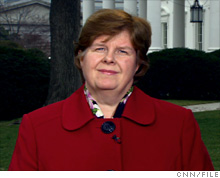Federal action prevented second Great Depression -- White House
President Obama's chief economic adviser says quick government response averted collapse over the past year.
 |
| Christina Romer, chair of the Council of Economic Advisers. |
NEW YORK (CNNMoney.com) -- Without the bold steps taken by the federal government over the past year, the country could have fallen into a second Great Depression, said the White House's chief economic adviser.
Christina Romer, chair of the Council of Economic Advisers, said Tuesday evening the main difference between last year's economic crisis and the Great Depression was that the federal government took decisive action to shore up financial institutions and stimulate the economy.
"The policy response in the current episode, in contrast, has been swift and bold," said Romer, speaking at the National Economists Club in Washington D.C.
Romer's speech comes as the White House and Congressional Democrats defend their economic policy decisions in the wake of rising unemployment rates and withering attacks by the GOP.
Romer also used the speech to press for an overhaul of the nation's financial regulatory system, which the Obama administration is advocating. She also pushed for the creation of a Consumer Financial Protection Agency, which would regulate financial products, such as mortgages and credit cards, with an eye toward protecting consumers against things like hidden fees and unfair rate hikes.
"We're getting pushback on, by far the most popular piece, the consumer financial protection," Romer said. "We get pushback on having the Federal Reserve be the regulator of systemically important institutions. We have no illusions; we're going through health care. We're used to it. We're up to the fight."
The Troubled Asset Relief Program, passed by Congress a year ago, gave banks the capital infusions they needed to survive, Romer said. Many of the institutions are paying back the funds with interest. The stress tests, which measured the health of the nation's 19 largest banks in the spring, were also critical.
"As it turned out, the scrubbing of the books of our major financial institutions, and the public release of that information, calmed fears and led to a much needed and very valuable wave of private capital raising," she said.
Meanwhile, the $787 billion stimulus program enacted soon after President Barack Obama took office was "the boldest countercyclical fiscal expansion in American history," Romer said. The Council of Economic Advisers found that the stimulus program has boosted the gross domestic product by roughly 2 to 3 percentage points in both the second and third quarters. Also, it created or saved about 1 million jobs.
Going forward, the challenge remains to improve the labor market, she said. The stronger the growth in the economy, the more likely businesses will start hiring again.
That's why officials need to be very careful in winding down the programs enacted over the past year. Mistakes made during the Great Depression -- when the Federal Reserve tightened hold over the banks and the government pulled back on its spending -- lengthened the downturn's hold over the country, she said.
"To talk seriously about stopping policy support at a time when the unemployment rate is nearing 10% and still rising is to risk nipping the nascent recovery in the bud," she said.
CNNMoney.com Senior Writer Jennifer Liberto contributed to this report. ![]()


